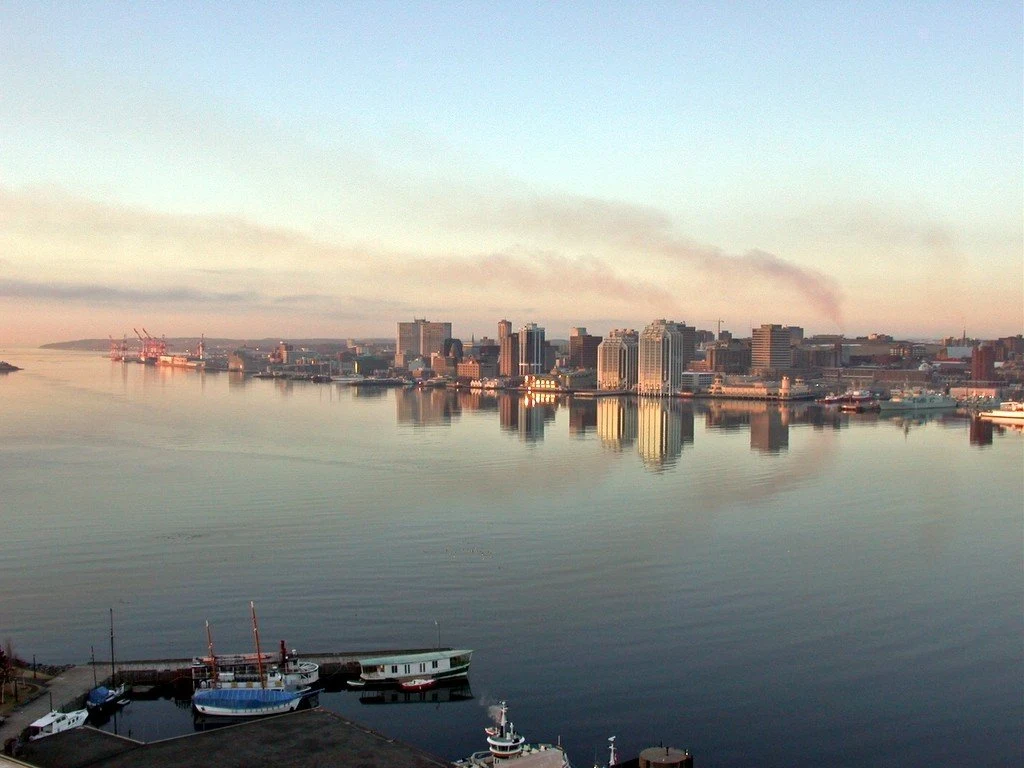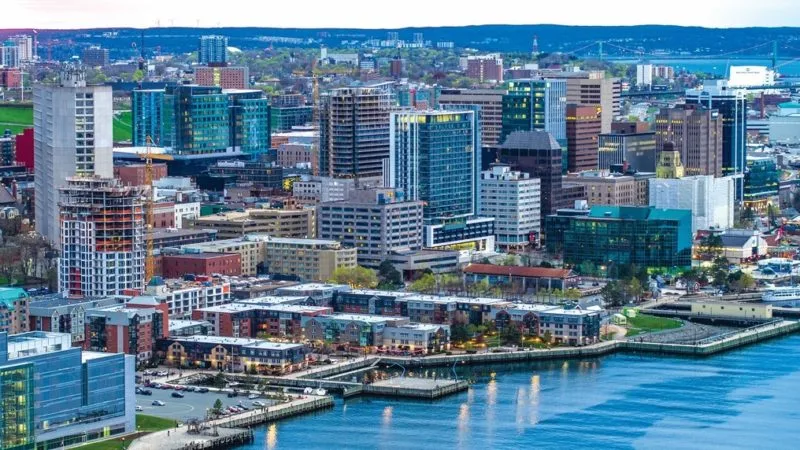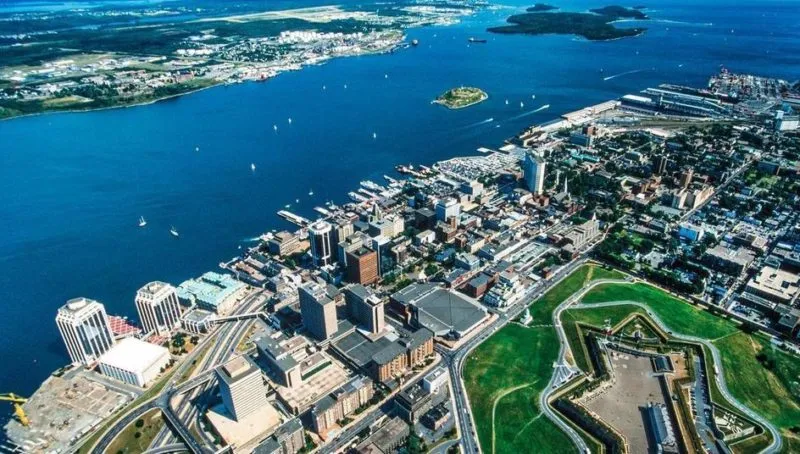Halifax is a city in Nova Scotia, Canada, a major Atlantic port where you can see ships of the Canadian Navy and fishing trawlers. Here, too, an atmosphere of serenity prevails, created by yachts and sailboats gracefully sailing in and out of the boathouses of Northwest Arm.
 |
| Halifax |
History
Attracted by the natural harbor, the British founded Halifax in the middle of the 18th century. as a military fortification and shipbuilding center to counter the French fortress of Louisbourg further north on Cape Breton Island. And soon Halifax became an important port for fishermen who hunted cod and herring on the rich shallows of the ocean shelf. It was also a favorite haunt of pirates and smugglers; they used it from the Napoleonic Wars to the Prohibition era in the US in the 1920s. Samuel Gunard (1787-1865) founded his famous transatlantic transportation line, whose wealth was acquired mainly through privateering.
Today, the old shipyards and warehouses with adjacent houses have been carefully restored. Received the status of a historic quarter, they form a bright and lively area with art studios and galleries, shops, restaurants and taverns. A wooden pavement will take you through an architectural kaleidoscope of red brick, wooden beams, gray stone and brightly painted planks.
 |
| Halifax |
What to Watch
Halifax Harbor is one of the largest natural harbors in the world. There are many cruises on offer, giving you the opportunity to view shipyards, naval bases, fishing fleets, as well as yacht clubs and elegant waterfront homes in Northwest Arm.
Also in the port, at 1675 Lower Water Street, is the Maritime Museum of the Atlantic (Maritime Museum of the Atlantic; open: June-Sept. daily 9.30-17.30, Tue to 20.00; Nov.-Apr. Tue 9.00-20.00, Wed 9.30- 17.30, Sun 13.00-17.00, Oct and May Mon, Wed-Sat 9.30-17.00, Tue until 20.00, Sun 13.00-17.30). It occupies a restored building of the ship supply agency from the early 20th century, where the nostalgic smell of tarred ropes is still felt. The museum's exposition introduces more than 200 years of history of the exploration of the Atlantic: you will see navigational instruments, weapons and excellent models of sailing ships and steamships, including the ocean liner Aquitaine. A special section is devoted to shipwrecks on the infamous Sable Island. The first in Canada is moored to the museum pier (1913)survey vessel "Acadia", which carried out measurements that made it possible to map the coast of Eastern Canada from Nova Scotia to Hudson Bay.
 |
| Halifax |
In the center of the city, on Hollis Street, a stately Georgian stone building (1819) stands out. This is the Province House, where the oldest legislature in Canada, established by Loyalists from New England, sits. In front of him is a statue of Joseph Howe, a champion of press freedom and democratic government, but a determined opponent of joining the Confederacy.
For a good panoramic view of Halifax and a sense of its important role in Canadian military history, climb the grassy slope leading to the star-shaped citadel (open: daily May-June and Sept.-Oct. 9.00-17.00, Nov.-Apr. only the surroundings 9.00-17.00). Since the 1850s from this fortress every day at noon a cannon volley is fired. An excellent guided tour includes a tour of the camp, built to house 300 British soldiers. It is surrounded by a deep dry moat, powerful walls and bulk fortifications.
The cavalry building, restored to its original form in 1869, now houses the Army Museum (open: May-June and Sept.-Oct. 09.00-17.00, July-Aug. 09.00-18.00) with uniforms, weapons and models of the three previous city fortresses. Barrels of gunpowder were stored in the southern warehouse, dangerously close to the prisoners of war. During World War II, an anti-aircraft battery was located in the fortress.
In the summer, students in kilts from the 78th Mountain Regiment perform infantry and artillery exercises. The Royal International Festival of Military Parades (late June or early June; Halifax Metro Center ice complex) has a more spectacular program - with bagpipe processions, highland dances, song and acrobatic numbers.
 |
| Halifax |
Looking east from the fortress, you will see a popular city landmark - an old tower clock. This octagonal tower was erected in 1803 by Prince Edward, Duke of Kent, commander of the armed forces of Nova Scotia (and future father of Queen Victoria), who was famous for his punctuality. At the south end of Grand Parade stands St. Paul's Church, Canada's oldest Anglican church (1750).
To the west of the fort, on Summer Street, is the Nova Scotia Museum of Natural History (open: June-mid-Oct. Tue-Sat 9.30-17.30, Wed-20.00, Sun 13.00-17.30; mid-Oct-May Tue-Sat 9.30- 17.00, Wed to 20.00, Sun 13.00-17.00), which has very interesting exhibits, among which, for example, objects of 11,000 years ago related to the culture of the Mikmaq Indians. You will see clothes, tools and artifacts, the use of which is clearly demonstrated by modern Indians; in addition, there are colonial ceramics, glass and pine furniture, often skillfully painted in oak or mahogany. The exposition dedicated to wildlife introduces the life of representatives of the local fauna: elks, bears, coyotes, eagles, etc. The museum also has excellent seasonal exhibitions.
In the Halifax Public Garden (open: daily May-Oct.), south of the museum, you can go for a walk around the duck pond; while you will be surrounded by very exotic vegetation: Chinese ginkgo and "pigeon trees" with their snow-white flowers, cork birches, Japanese lilacs and larches... Sometimes open-air concerts of string music are held here. Point Pleasant Park at the southern end of the peninsula, with its cozy forest and excellent beaches, is popular with hikers and joggers; it also offers a magnificent view of the Northwest Arm.
Among the ruins of the old fortifications is the Prince of Wales Tower (open: daily July-Aug. 10.00-18.00), built by Prince Edward in 1796 and preserved intact to this day. This tower, one of five in Nova Scotia, was the first of the round stone "guards" erected on the coast of North America and the British Isles. They were used both as barracks, and as a place to store weapons, and as gun platforms.
Fairview Cemetery, on the northwestern outskirts of the city, is the burial place of the many victims of the Titanic, which sank in 1912 in waters south of Newfoundland.
At the other end of Halifax is Fort Needham Park, established to commemorate the tragedy of December 6, 1917, known as the Halifax Explosion. On that day in the harbor of Halifax, the French ship "Mont Blanc" with a cargo of ammunition and explosives collided with another ship. The massive explosion killed 2,000 people and maimed several thousand more. This greatest man-made cataclysm destroyed half the city.
The recently restored Pier 21 National Historic Site (open May-Nov daily 9:30-17:30, Dec-March Tue-Sat 10:00-17:00) overlooks Halifax Harbor. The last surviving overseas immigrant hangar in Canada presents the stories of a million people who arrived there between 1928 and 1971. Military widows, lost children and Canadian soldiers who fought abroad also passed through its doors.
